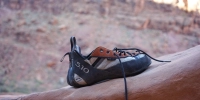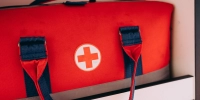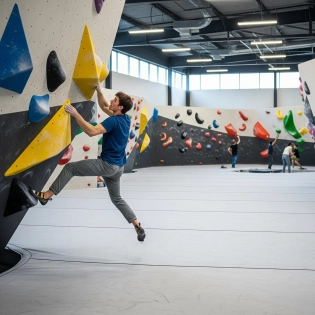







Climbers Point
The jeans rock climbers wear are not ordinary jeans. They have specific qualities that make them comfortable while climbing, such as being more stretchy and breathable than normal jeans
These jeans are typically very comfortable, and are thick enough to also help prevent those small but annoying skin scrapping injuries.
Some climbers also prefer wearing these jeans because they just look more stylish.
Rock climbers are very efficient at pacing themselves, and only exerting the required amount of energy, and no more. They achieve this through training, experience, and properly reading the route.
Climbers do in fact get tired, just after a different amount of time than others, and they are able to handle it better than others.
In order for a climber to complete a route, which can sometimes very long and physically demanding, they must first understand the route and it's requirements, and what options they have that can help them finish it. Based on that, and on an understanding of what their own strengths are, they will decide on the beta that suits them best.
Knowing what they need to do on the route and properly reading it and coming up with the correct beta for themselves also allows them to find good resting spots. These resting spots are crucial for long and tough routes, as the climber can spend enough time in these resting spots to recover and to reduce the pump in their arms.
Climbers also train very hard in order to reduce the effects of the pump they feel in their arms, so that they are able to climb through it better, and to delay the pump from ever happening.
Not really. Climbing is more of a pulling exercise for the upper body. This basically leaves your chest and triceps sort of neglected, which is why many climbers do antagonist training such as push-ups, dips, and bench presses.
There are some climbing moves such as mantles that use your triceps, and to some very slight extent, your chest. But for the most part, your chest is not used enough to build it a lot, at least not as much as your other muscles are used, such as your back. Which, again, will cause an imbalance in your muscles if you don't train your chest and triceps specifically. Your posture could be effected by this quite a lot.
But, it doesn't mean that you have to bleed all over the holds..
Wrap it up. Really, it will be better for you and for everyone else.
Training antagonist muscles is very important for proper muscle balance and to prevent injuries.
Push-ups are a great way to train the antagonist muscles. It targets your chest muscles, triceps, and shoulders. There are also many different variations of push-ups that can make them more challenging, difficult, and effective.
Here are some of the different push-up variations:
- Close hands
- Wide hands
- Unbalanced hands (one hand up high, the other lower down), this puts more emphasis on different muscles for each arm
- Leaning forward
- Elevated feet
- Handstand push-ups
- Adding weights on your back
Climbing is mostly a pulling sport for your upper body. You will spend most of your time pulling with your arms, and pushing with your feet. But, there are times and certain moves in climbing that require you to push with your arms, such as when doing a mantle. This is where having strong triceps and chest muscles can be useful.
Here are 6 exercises and tips that I use that have helped me climb better and get better at bouldering:
1. Slow and Quiet Climbing
This is probably one of my favorite exercises, and one I do every time I go climbing as a warm-up, and as I finish climbing.
What you do is you simply climb easier routes, but quietly. If you make any sound at all (not including clicking sounds from fingers or legs, or sounds from the shoes such as the rubber or the Velcro), you get off the route, and start the route over again.
What this does is it teaches you to be more precise with your movements and hand and foot placements, as you have to really grab the hold slowly and softly to not make a sound.
It strengthens your muscles because as you climb slowly, you will find yourself in more lock-off positions, where you are holding your body weight with more of your muscles.
It's a great warm-up when doing it on easier routes, and is great for some extra low intensity climbing at the end of the session, but, it's also a great exercise to keep in mind while climbing difficult routes also, as the precision in the movements and limb placements can really make a huge difference in the harder routes.
It's a great exercise to really give your technique a boost.
2. Moonboarding or other tension boards
Strength may not necessarily be more important than technique, but it is important. Grip strength, finger strength, and pinch strength are crucial for climbing harder routes, especially for overhanging routes.
Grip and pinch strength can be trained in isolation with punch blocks and other gear, but one of the best ways I have found to increase my strength, and not just in my hands, is the moon board. It is also much more interesting than just lifting a block of wood for a few seconds as you are actually climbing. It also strengthens your core, shoulders, back, and other muscles in addition to just grip strength.
If you have a moonboard or any kind of tension board, I highly recommend dedicating a session or two per week to climbing only on it. After even just a month, you should be able to see the difference in your strength.
3. Projecting
Many climbers choose to only climb routes that are around their climbing level. This could be out of comfort, or out of the idea that they just can't climb harder routes because they are not there yet.
Climbing routes that are above your climbing grade can actually be one of the best things you can do for your climbing.
First of all, you may actually be surprised and may be able to climb the harder routes.
If not, even if you work on the route and get just a few movements in, those movements can go a long way in improving your overall climbing abilities, knowledge, and experience.
Plus, when you actually finish the route, the amount of motivation you will feel will be unmatched, a perfect dose for climbing harder and choosing another project.
4. Strength training
As mentioned, strength training is very important. Not just finger strength, but general body strength. This includes the back, shoulders, arms, chest, core, and legs.
Also, training antagonist muscles is very important as it can help prevent injuries due to imbalances and poor posture.
I would add a few weight lifting or body weight training days to your climbing schedule, to make sure that you are giving your whole body a proper workout.
5. Feet work
Most beginner climbers don't understand the importance of feet work. They think it's just an upper body sport, mainly for the back and arms.
This is very far from the truth, as feet work can be the defining element between success and failure on a route. You can be as powerful and as strong as you want, but if you have poor footwork, everything will just be that much harder for you.
Climbers who are not very strong often times climb better than those who are because they have much better technique and foot work. They cannot rely on their strength since they don't have that much, so they climb with increasingly better technique.
6. Flexibility
I have seen flexibility being the element that allowed some climbers to send their projects. It is underestimated in importance. People either think it is not that important, or, they just don't want to do it because they don't like it.
This is unfortunate, because being flexible just gives you that extra advantage on the wall, and on the routes where strength is just not enough.
Traditional indoor boulder walls are usually around 15 feet (4.5 meters) tall.
This is not an indication for how long the actual route is, though, since the climbing route may actually be shorter or longer than the wall itself due to the angle of the wall, and to the structure and design of the routes. If the wall is very overhanging, the wall or boulder may be shorter than 15 feet, but the route itself could be longer. Imagine a cave ceiling, it could be rather short in height from the ground, but, the route could span much of the actual cave ceiling, making the route much longer than the actual height of the cave.
Outdoor boulders can be of any height really, though at some point they are considered sport climbing routes, but generally, outdoor boulders can be much taller than 15 feet.
Rock climbing is a great sport as really almost anyone can do it, regardless of their fitness level.
There are a few types of climbing, but the simplest one is indoor bouldering. Boulders are short routes, usually up to 15 feet (around 5 meters) tall. You don't really need any equipment besides climbing shoes, and a chalk bag, but even those can usually be provided by the climbing gym.
The goal of bouldering is to climb from point A to point B. The rules are fairly simple, though each climbing gym may have their own variation of the rules. The basic rules are to start from the starting hold, and to finish the route by touching the finish hold with two hands. There is a mat at the bottom of the routes to make falling/getting down safe.
The reason why this is the simplest form of climbing, mainly for beginners, is because it’s very simple to just start climbing, you do not need to depend on anyone, you can do it alone, and the beginner routes are just very easy to climb, they are very much like climbing ladders. As you progress in the grades, the routes will become more complex and physically demanding, but also mentally demanding.
This is where things start to get more interesting, and why people looking to start a new sport should consider rock climbing. Climbing is not only a physical sport, it is also a mental one. You can think about climbing and boulder problems as puzzles. Your goal is to solve the puzzle by understanding the route, it's requirements, and how you can physically complete the puzzle. To do this you have to understand what the route requires from you, and what your physical strengths are, skills, and technique.
There is a lot of thought and puzzle solving that goes into climbing, it's not just a matter of getting on the route and climbing to the top with all the strength you have, sometimes the routes require far more technique than strength.
The chest muscles are some of the only muscles that are not directly worked when climbing. Climbing does build many muscles in the body, even legs to some extent, but the chest muscles are just barely used while climbing.
While climbing, your body is under general tension, and there are specific moves that do use the chest muscles, but they don't occur so often as to actually give your chest a good enough workout.
This is why climbers should also include antagonist training and exercises into their schedule to help build the muscles that are not really worked enough through climbing, otherwise they could suffer muscle imbalances that eventually could lead to bad posture and to injury.
Climbers sand their fingers to prevent skin injuries such as flappers, cracks and tears. This happens due to calluses building up.
Climbing is pretty rough on the skin, and after doing it for a while, you start developing calluses. This is a natural process of the body and is meant to protect the skin. The problem climbers have, is that after some time, the calluses can actually build up and cause potential skin injuries.
The skin injuries can occur due to different reasons, such as the callus area being very dry, or when a callus is caught or pinched on a hold, which can cause the callus to peel off, which is known as a flapper.
Climbers tend to sand down the calluses to reduce their size, and make them a little bit smoother so that they don't get caught and rip off.





